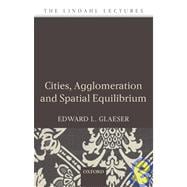
Note: Supplemental materials are not guaranteed with Rental or Used book purchases.
Purchase Benefits
What is included with this book?
| Introduction | p. 1 |
| What is this book? | p. 10 |
| A quick overview of the influences on this book | p. 11 |
| The plan of this book | p. 14 |
| The spatial equilibrium within the city | p. 18 |
| Spatial equilibrium in the Alonso-Muth-Mills model | p. 18 |
| Transport technologies | p. 23 |
| Endogenizing land areas | p. 25 |
| Building housing | p. 29 |
| Income heterogeneity | p. 33 |
| Endogenous and exogenous amenities | p. 37 |
| Job decentralization within the metropolitan area | p. 40 |
| Using the model to understand urban history | p. 44 |
| The spatial equilibrium across cities | p. 47 |
| The static model and the Rosen-Roback framework | p. 49 |
| The dynamic framework and urban growth | p. 68 |
| Multiple skill levels and the rise of the skilled city | p. 80 |
| Housing supply heterogeneity and urban decline | p. 99 |
| High frequency housing price dynamics | p. 111 |
| Agglomeration economies | p. 116 |
| Income and density | p. 117 |
| Measuring concentration: Natural advantage vs. agglomeration | p. 125 |
| Reducing transport costs | p. 131 |
| The division of labor is limited by the extent of the market | p. 138 |
| Labor market pooling | p. 141 |
| Matching in cities | p. 144 |
| Learning in cities | p. 148 |
| Testing different theories: The coagglomeration evidence | p. 154 |
| The evolution of agglomeration economies | p. 156 |
| Urban distress | p. 165 |
| The causes of urban poverty: Housing, spillovers and transportation | p. 166 |
| Racial segregation | p. 175 |
| Neighborhood effects, social interactions, crime and riots | p. 188 |
| Cities, crime and ritos | p. 195 |
| Cities and public policy | p. 204 |
| Urban political economy | p. 204 |
| Optimal place-based policies | p. 221 |
| Local tax policy | p. 236 |
| Land use controls | p. 238 |
| Proofs of propositions | p. 245 |
| References | p. 251 |
| Index | p. 259 |
| Table of Contents provided by Ingram. All Rights Reserved. |
The New copy of this book will include any supplemental materials advertised. Please check the title of the book to determine if it should include any access cards, study guides, lab manuals, CDs, etc.
The Used, Rental and eBook copies of this book are not guaranteed to include any supplemental materials. Typically, only the book itself is included. This is true even if the title states it includes any access cards, study guides, lab manuals, CDs, etc.